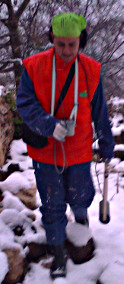 This Web Site describes all the phases and faces of our Proton Precession Magnetometer project which started back at the beginning of 2005.
This Web Site describes all the phases and faces of our Proton Precession Magnetometer project which started back at the beginning of 2005.
The objective of this project has been to produce the most effective PPM with an affordable price tag for non-professional users. The initial aim was to experiment and publish the schematics of a DIY PPM.
The first phase of the project was devoted to gathering and studying all the information required to master this technology. It was at this point I met my current partner on this project, Jim Koehler.
He is a former Professor of Physics and Engineering Physics at the University of Saskatchewan. He retired to the ComoxValley in 1996 where he enjoys the good weather, superb scenery and the complete absence of mosquitoes!
For the past number of years, he has been quite interested in proton precession magnetometers and lost count of how many versions of the electronics that were built. The theory and practice of these sensitive instruments is given in this ProtonPrecessionMagnetometers. The spreadsheet referred to in the paper is located there ppm_1.
I have published all I could gather together with the summary of my analysis and practical applications in this series of documents: PPM Guidelines.
From these documents, one can already learn the basic principles and make his own PPM for experimental testing.
Progressively, Jim and I have found that there was still a large gap between the quality of the results coming from a DIY system and the quality expected from professional companies even if we proved that a cheap, DIY PPM could be built by an amateur using largely available, cheap electronic components.
In order to cross this gap, we re-designed and built our systems using professional-grade material and services as well as more sophisticated and more powerful digital processing devices. Thus, we chose to use all SMD components, double sided PCB’s manufactured and assembled by professional companies and fast and powerful 32-bit ARM processors as digital signal processors.
The first mechanical assemblies we produced had a rather amateurish look and feel and could not be easily reproduced in series. Thus, we chose to sub-contract the building of the specific mechanical parts of the product like the sensor coils and containers.
Being a field instrument, we have also decided that the mechanical design of the electronic box needed to be water-tight (IP66), not just splash-proof.
Looking at the current status of our project, we have succeeded in producing a mature and reliable product with professional-grade specifications while keeping its affordable price.
Each phase of our project has produced its own prototypes which were thoroughly tested in terms of hardware and software before being released for sales.
Each product version has been improved over the previous ones with more functions, easier human interface and higher standards of quality instead of adding marketing gimmicks like flashy colors or any spectacular but useless features.
The current Mark VII version is our most advanced product with a mix of functional, electronic and mechanical specifications very rarely found in any equivalent commercial product.
This version is not a toy to be used by amateurs of treasure hunting but a sophisticated instrument which can be used by professionals in the field.
Not only can our instrument be used for underground surveys but its control box (with GPS option) can also be used for underwater surveys provided the sensor coils are contained in a pressure-protected container and its connecting cable extended, shielded and doubled with a proper towing cable.
Note that all the pictures displayed on the pages of this site are zoomed in when clicking on them.
